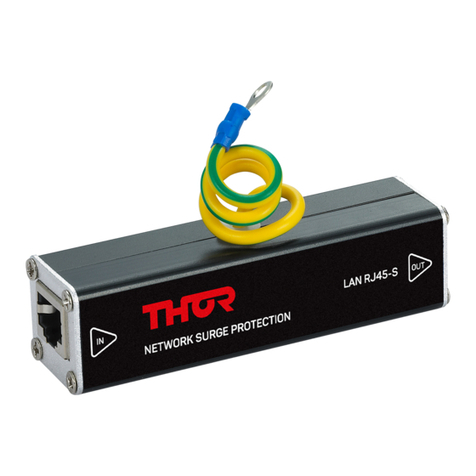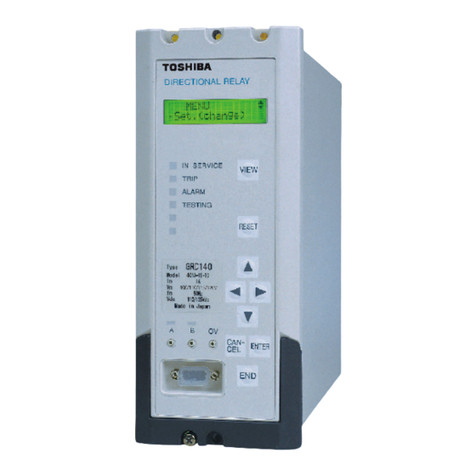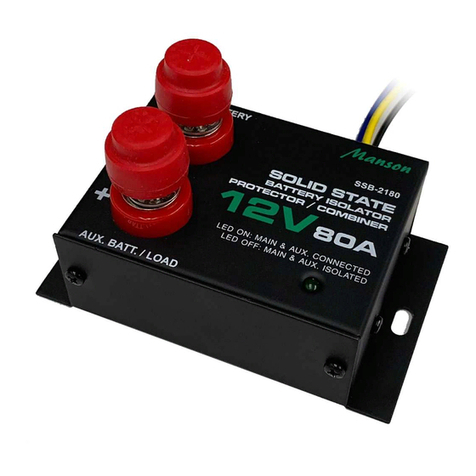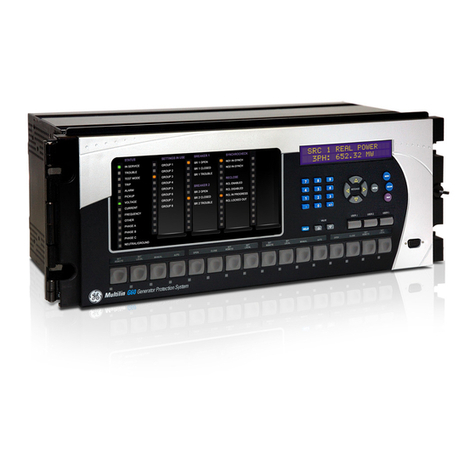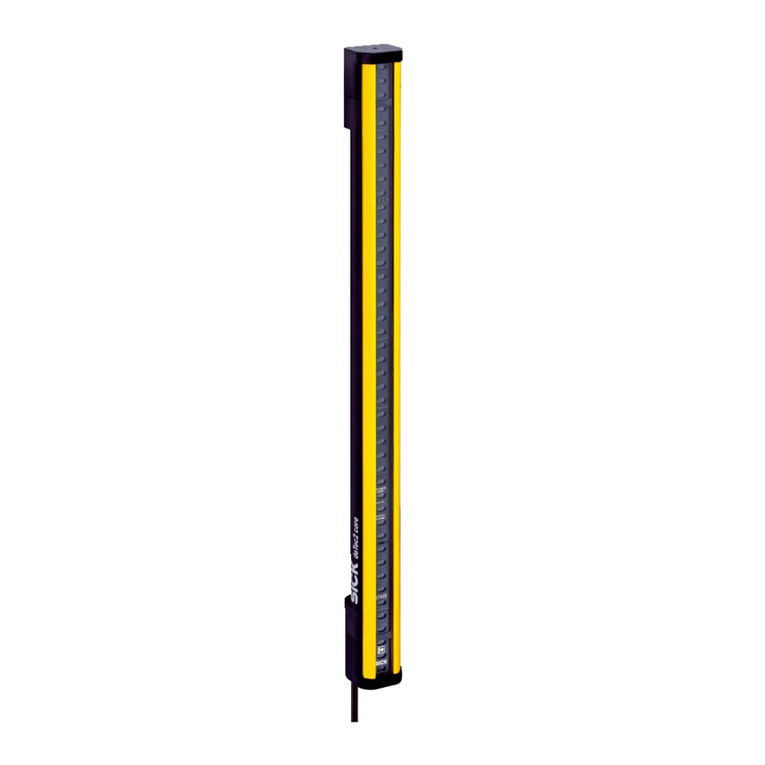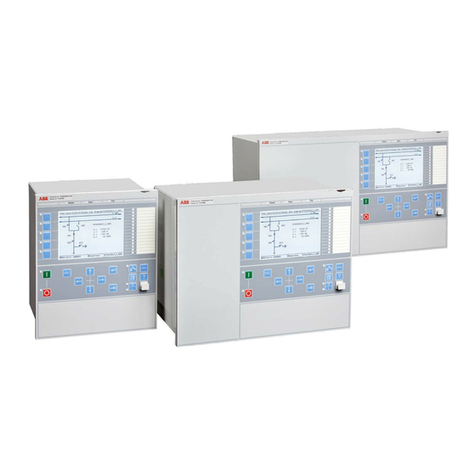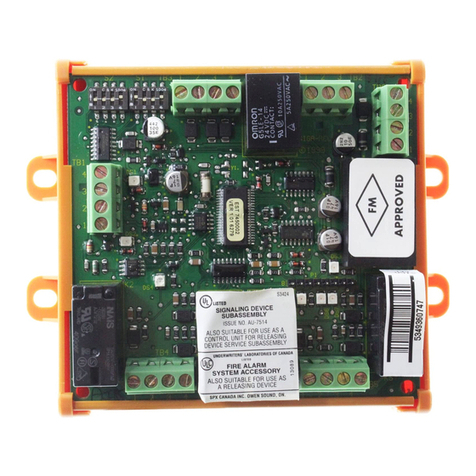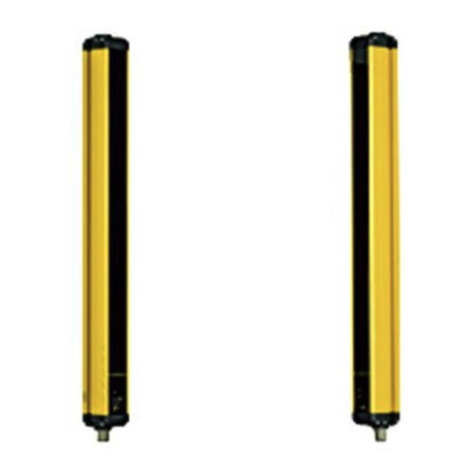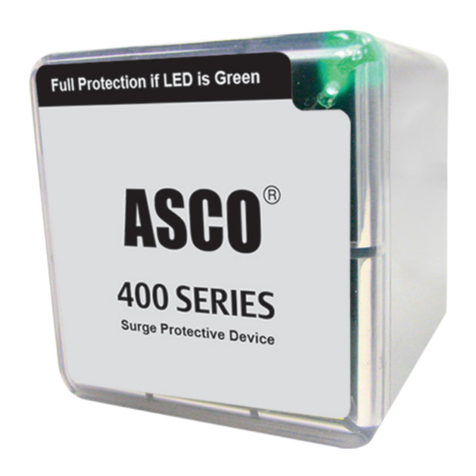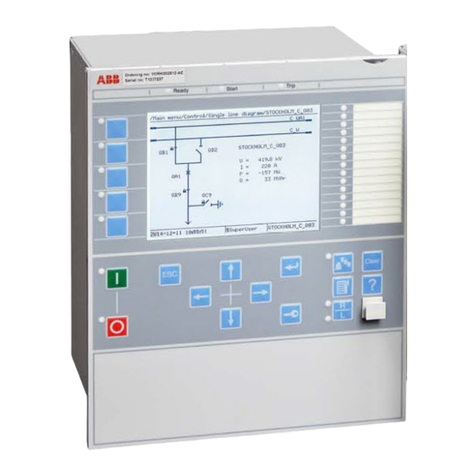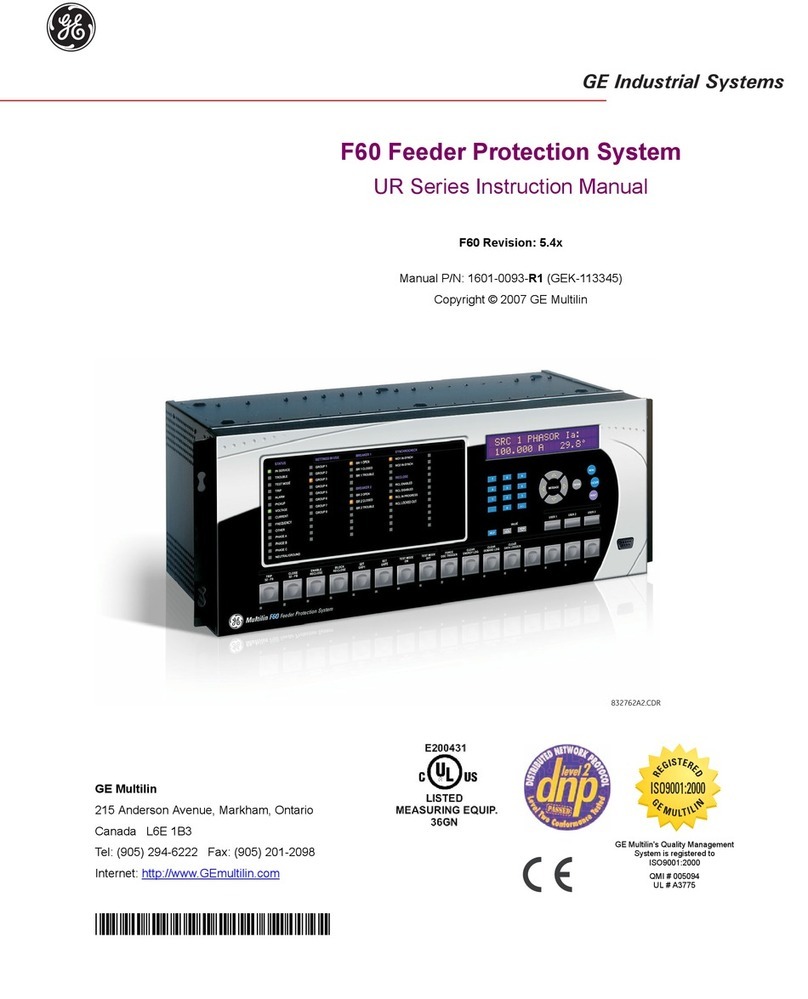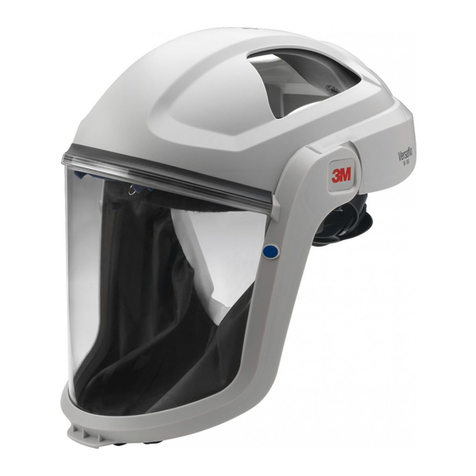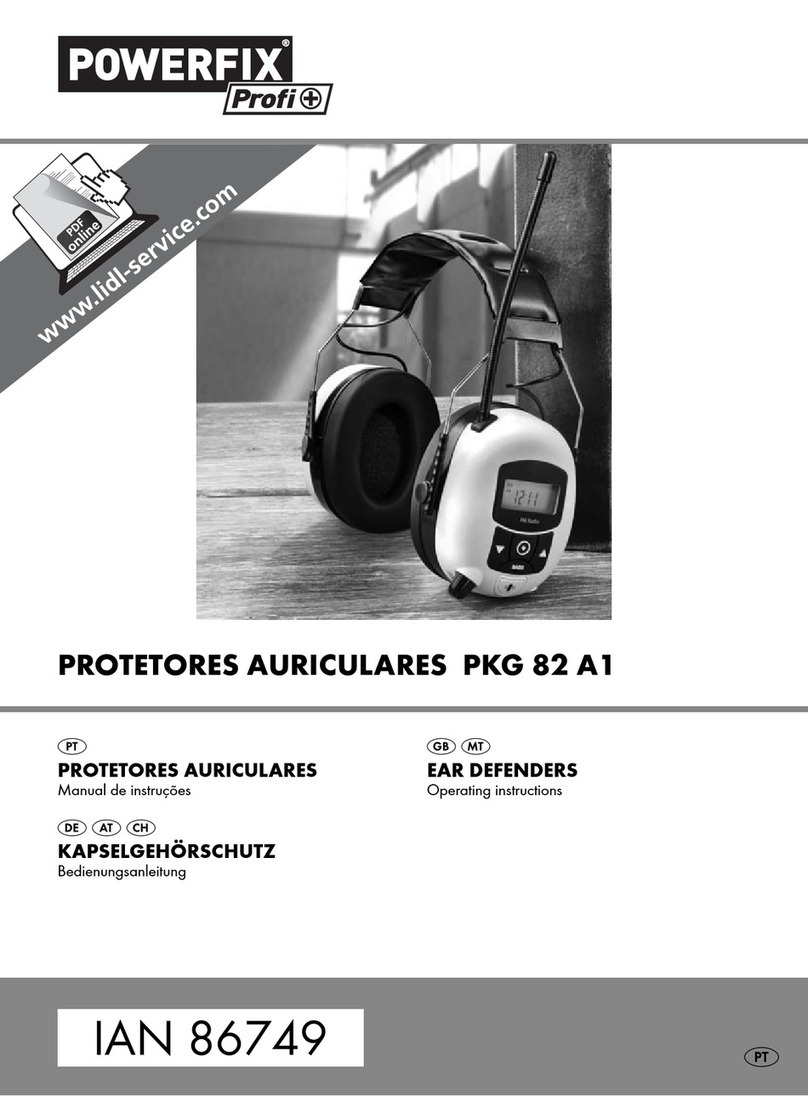FireFlex TOTALPAC2 User manual

Page 1 of 6
TOTALPAC2 Integrated Fire Protection System
Cycling Deluge Systems
FM-072G-0-142 E
General
1. Applicable Standards
The TOTALPAC2complies with the following standards:
- NFPA-13 Sprinkler Systems;
- NFPA-15 Water Spray Fixed Systems;
- NFPA-16 Foam-Water Deluge and Foam-Water Spray
Systems;
- NFPA-72 Fire Alarm Systems.
Before the installation, the contractor installing the unit shall
be familiar with the following documents and standards:
- Applicable Local & State Building Codes
- Any additional requirements of the Local Authority
Having Jurisdiction.
2. Listings and Approvals
In addition to being fabricated under tight ISO-9001
manufacturing and quality control procedures, your
TOTALPAC2Unit has also been tested and approved by
recognized laboratories:
Underwriters Laboratories Inc. (UL):
- Special System Water Control Valves - Assembled
Units, category # VKYL.EX4641".
Note: Although most TOTALPAC2units are Listed, custom
built units are sometimes supplied on request.
Components in these special units maintain their
individual Listings/Approvals but the units are not Listed
as an assembled unit.
CAUTION ! Any unauthorized modification or addition
made on-site to a factory built Listed Unit will void this
Listing. Such modifications or additions may void the
unit's warranty as well. Consult your nearest FireFlex
Systems Authorized Distributor before proceeding with
such modifications or additions.
3. Environment
TOTALPAC2units shall be installed in a dry and clean
location. Verify that all equipment is properly heated and
protected to prevent freezing and physical damage.
The unit and it's components must be kept free of foreign
matter, freezing conditions, corrosive atmospheres,
contaminated water supplies, and any condition that
could impair its operation or damage the components.
The frequency of the inspections and maintenance will
vary depending on these environmental conditions. The
owner is responsible for maintaining the fire protection
system and devices in proper operating condition.
Refer to CONFIGURATION DESCRIPTION for
maintenance instructions.
4. General Description
The cycling deluge system uses open type sprinklers and
/ or spray nozzles in the sprinkler piping which totally
flood an area with pressurized water. A detection
network is used in parallel with the open type sprinkler /
nozzles system. This network is electric and may be
actuated by manual and rate-compensated temperature.
When the detection system operates it gives an alarm
and activate the Flow Control valve. Because deluge
systems are often used in extra-hazard occupancies,
electrical detection systems are by far the most common.
The TOTALPAC2integrated fire protection system by
FireFlex Systems Inc. consists of a cycling deluge system
trim totally pre-assembled, pre-wired and factory tested.
All electrical and mechanical components of the system
are contained in one single unit.
The only connections required for installation are the
water supply inlet, water discharge outlet, main drain, and
the electrical detection and alarm connections. The
discharge outlet is connected to a fixed piping system of
open sprinklers and or nozzles. Water is the
extinguishing agent.
Cycling Deluge systems are usually supervised. The
TOTALPAC2system is supervised in order to monitor its
integrity. The electrical detectors and associated wiring
are also supervised.
The most common applications are protection of extra-
hazard occupancies by creating a fire buffer zone or by
cooling surfaces to prevent deformation or structural
collapse. Examples: storage or process areas containing
substances having a low flash point; areas in which fire
may spread rapidly; tanks containing combustible
solutions, transformers, equipment pits or product
handling systems.
Systems should be designed by qualified fire-protection
engineers in conjunction with the appropriate Authority
Having Jurisdiction.
Note: Each TOTALPAC2Unit is identified with it's unique
Serial Number. This number is located on a sticker
inside the main door panel and is used to maintain a
record in our computerized data base. Have this Serial
Number handy when calling for information on your unit
(format is TOT#####).

Page 2 of 6
TOTALPAC2 Integrated Fire Protection System
Cycling Deluge Systems
FM-072G-0-142 E
5. Features
Your TOTALPAC2unit is superior than many other products
available on the market now and has been manufactured by
the company that has introduced and developed the concept
of integrated fire protection systems in the market.
Main features are:
- Trouble free design for safe and easy application
- Available in 5 sizes from 1½" to 6" diameter
- Uses the Viking Flow Control Valve
- Integrated Control Panel
- Compact, aesthetic and easy to move
- User-friendly standardized owner's manual with every unit
- Unique serial number on every unit
- Uses only UL, ULC Listed and FM Approved components
- Designed in accordance with NFPA Standards
- Trim is fully assembled and tested at the factory
- Water supply and drain connections on both sides,
available both with grooved end or flanged fittings
- Sturdy 14 Gauge steel cabinet or skid painted fire red with
oven baked polyester powder on phosphate base
- Textured rust proof finish
- Neoprene gasket on all doors to eliminate vibrations
- Easily removable doors for ease of access
- Key-alike locks on all cabinet doors
- Manufactured under ISO-9001 quality control procedures.
Configuration Description
A Deluge system is a fixed fire-protection system which
totally floods an area with pressurized water through a
system piping of open nozzles or sprinklers. The system
piping is empty until the Flow Control Valve is activated by an
electric or manual release system.
TOTALPAC2Cycling Deluge systems are built around the
Viking Trim using Flow Control Valves Model H-3 for 1½" (40
mm) diameter (Model H-4 is the Halar®Coated version for
use in corrosive environments) or Model H-1 for 2" (50 mm)
diameter and up (Model H-2 is the Halar®Coated version for
use in corrosive environments).
All the valves are rated up to a maximum of 250 psi WWP
(1724 kPa) and are available in the following diameters:
1½" (40 mm) 2" (50 mm)
3" (80 mm) 4" (100 mm)
6" (150 mm)
Cycling TOTALPAC2Deluge systems are supplied with
flange–groove Flow Control Valves. Units with flange–
flange Valves are also available on request.
Release System
The Viking Firecycle® III cycling deluge system utilizes a
Viking Flow Control Valve (A2) in lieu of the Deluge Valve
and a Firecycle® III Model E-2 Control Panel, together with
additional valves, devices and trim to form a unique operating
system.
In fire condition, when the detection condition is satisfied the
system Control Panel energizes both Solenoid valves (F1 &
F2) , causing the Flow Control Valve (A2) to open allowing
water to enter the system piping. Water will flow from any
open sprinklers and/or spray nozzles on the system.
In addition, Firecycle® III has the added ability to sense when
the fire has been controlled, and automatically turn off the
water flow once a preprogrammed "Soak Timer" has been
satisfied. Should the fire rekindle, the Firecycle® III will
initiate the sequence again. This unique cycling feature will
repeat as long as power is available to the panel, helping to
minimize water usage, water damage, and the danger of
pollution to surrounding areas. Firecycle® III systems are
also "Fail-Safe".
Note: TOTALPAC2FirecycleIII Deluge Systems are
available with electrical type release and the integrated
FirecycleIII Model E-2 Control panel. They are not FM
Approved.
The system piping is normally dry and may be installed in
locations subject to freezing.
The Firecycle® III Cycling System has several "Fail-Safe"
features, some of which are not available on other deluge
systems. Refer to SYSTEM OPERATION for more details.
INSTALLATION
TOTALPAC2Units must be installed in an area not subject to
freezing temperatures or physical damage.
1. Install the TOTALPAC2unit and connect the system
according to instruction manual and technical data
supplied.
Note: The drain collector shall be connected to an open
drain. Do not restrict or reduce drain piping.
2. Install the open sprinklers/nozzles piping, detection and
signaling circuits in accordance with applicable NFPA
standards.
3. Conform to local municipal or other codes regarding
installations of fire protection systems.
4. Perform preliminary inspection outlined below prior to
putting system in service.
5. Put the system into operation as outlined below.
6. Perform the annual inspection sequence and test each
detector and alarm unit.
7. If the system does not operate as it should, make the
necessary corrections according to manuals issued or
consult your distributor or FireFlex Systems Inc.
8. Make sure that building owner or a delegated
representative has received instructions regarding the
operation of the system.

Page 3 of 6
TOTALPAC2 Integrated Fire Protection System
Cycling Deluge Systems
FM-072G-0-142 E
PRELIMINARY INSPECTION BEFORE
PLACING THE SYSTEM IN SERVICE
1. Open door to mechanical section. Main Water Supply
Control Valve (D1) should be CLOSED. Priming
valve (B1) must be CLOSED. Flow Test Valve(B6)
and main drain valve (D3) must be CLOSED. Alarm
test valve (B5) must be CLOSED. All gauges (B11,
B12 and E3) should show 0 psi pressure.
2. Connect all detection and alarm audible devices
according to electrical schematics (see TBA field wiring
diagram in PROGRAMMING SECTION).
3. Connect the AC power for the control panel (L1) on a
separate breaker in the electric distribution panel (see
TBB field wiring diagram in PROGRAMMING
SECTION).
Note: Do not use these circuit breakers for other parallel
applications. If necessary, equip each circuit breaker with
a security seal in order to avoid accidental closing.
4. After the Flow Control Valve is set, operation of the
valve requires the release of priming water from the
priming chamber. This may be by automatic or manual
operation of one of the release systems described
above. For specific trim arrangement, refer to the
MECHANICAL TRIM DESCRIPTION.
Note: Electric Release: Solenoid valves, system control
panels and electrical detectors must be compatible.
Consult the CONTROLS SECTION for compatibility charts.
PLACING THE SYSTEM IN SERVICE:
(Refer to mechanical trim description and TRIM
SCHEMATIC)
1. Verify the following:
a) The system Main Water Supply Control Valve (D1) is
CLOSED.
b) The system has been properly drained.
c) Flow Test Valve (B6) is OPEN.
d) The Emergency Release Valve (B10) is CLOSED.
e) The system water supply piping is pressurized up to
the CLOSED Main Water Supply Valve (D1) and the
priming line is pressurized up to the CLOSED
Priming Valve (B1).
2. Verify that all releasing devices are set and that any
Inspector's test Valve and/or auxiliary drain valves are
CLOSED.
a) OPEN Priming Valve (B1).
3. OPEN Flow Test Valve (B6).
4. PARTIALLY OPEN Main Water Supply Control Valve
(D1).
5. When full flow develops from the Flow Test Valve (B6),
CLOSE the Flow Test Valve.
a) Verify that there is no flow from the open Flow Test
Valve (B6).
6. CLOSE Flow Test Valve (B6).
7. FULLY OPEN and secure the Main Water Supply
Control Valve (D1).
8. Verify that the Alarm Test Valve (B5) is CLOSED and
that all other valves are in their "normal" operating
position (Refer to TRIM SCHEMATIC for details).
9. Depress the plunger of the Drip Check Valve (B7). No
water should flow from the Drip Check when the plunger
is pushed.
10. Check and repair any leaks.
11. On new installations, systems that have been placed out
of service, or where new equipment has been installed,
trip test system to verify that all equipment functions
properly. Refer to MAINTENANCE – ANNUALLY for
instructions.
CAUTION ! Performing a trip test results in operation of the
Deluge/Flow Control Valve. Water will flow into the sprinkler
piping. Take necessary precautions to prevent damage.
12. After completing the trip test, perform MAINTENANCE –
SEMI-ANNUALLY.
Note: When a valve has been removed from service and is
subject to freezing or will be out of service for an extended
period of time, all water must be removed from the priming
chamber, trim piping, water supply piping and any other
trapped areas.
13. Notify the Authority Having Jurisdiction, remote station
alarm monitors, and those in the affected area that the
system is in service.
MECHANICAL TRIM SECTION
1. System Operation
In the SET condition:
System water supply pressure enters the priming chamber
of the Flow Control Valve (A2) through the priming line
which includes a normally open priming valve (B1), strainer
(B2), restricted orifice (B3) and spring loaded check valve
(B4).
System water supply pressure enters the priming chamber
of the Flow Control Valve. In the SET condition, water
supply pressure is trapped in the priming chamber by a
spring loaded check valve (B4) and normally closed
Solenoid valve (F2). The pressure in the priming chamber
holds the Flow Control Valve clapper closed, keeping the
outlet chamber and system piping dry.
In a fire condition:
When the detection condition is satisfied, system Control
Panel activates an alarm and energizes normally closed
Solenoid valve (F2) open and normally open solenoid
valve (F1) closed.
Pressure is released from the priming chamber of the Flow
Control Valve (A2) to the open drain manifold faster than it
is supplied through the restricted orifice (B3). The Flow
Control Valve clapper opens to allow water to flow into the
system piping and alarm devices, causing the optional
Water Motor Alarm (C2) and water flow alarms connected
to the Alarm Pressure Switch (C1) to activate.
When the Flow Control valve operates, the PORV (B14) is
pressurized, causing it to latch open.

Page 4 of 6
TOTALPAC2 Integrated Fire Protection System
Cycling Deluge Systems
FM-072G-0-142 E
Water discharges until all Firecycle® detectors have reset
(cooled below their set point). After all detectors have
reset, the Firecycle® III control panel activates the Soak
Timer, allowing the system to flow water for a pre-
determined period of time. When the Soak Timer has
elapsed, the control panel de-energizes the normally
closed Solenoid valve (F2), allowing it to close (the
normally open solenoid (F1) remains energized closed until
the system is manually reset or all power (both AC and
batteries) is lost).
The Flow Control Valve re-primes and closes, stopping the
flow of water through the piping system. Should a
Firecycle® detector go into alarm, the control panel re-
energizes the normally closed solenoid valve (F2) open,
and the entire cycle repeats.
Trouble conditions:
If the detection system is damaged or malfunctions, the
FirecycleIII Control panel will go into alarm and the Flow
Control Valve (A2) will open. Water will flow from any
open sprinklers and/or other opening in the sprinkler
piping. The cycling function of the FirecycleIII will not
operate in this condition. All alarms will operate normally.
If the AC power fails, the FirecycleIII System continues
to operate on the standby batteries. Should both AC and
batteries fail prior to the operation of the system, all alarms
will be lost and the system will need to be manually
actuated. The cycling function of the system will not
operate in this condition, and the system must be manually
shut-off.
If power fails while the system is flowing water, the
normally open Release Solenoid (F1) will fail open. The
PORV (B14) is already pressurized open, continually
venting the priming chamber of the Flow Control Valve
(A2). The cycling function of the system will not operate in
this condition, and the system must be manually shut-off.
Manual operation:
Anytime the handle of the Emergency Release (B10) is
pulled, pressure is released from the priming chamber;
Flow Control Valve (A2) will open. Water will flow from any
open sprinklers and/or other opening in the sprinkler piping
and alarm devices (C1 & C2) will operate.The cycling
function of the Firecycle III®will not operate in this
condition due to the open Emergency Release (B10).
2. Emergency Instructions (refer to piping diagram
provided)
To take system Out of Service:
Warning ! Placing a control valve or detection system out of
service may eliminate the Fire Protection capabilities of the
system. Prior to proceeding, notify all Authorities Having
Jurisdiction. Consideration should be given to employ a fire
patrol in the affected areas.
After a fire, verify that the fire is OUT and that placing the
system out of service has been authorized by the
appropriate Authority Having Jurisdiction.
.1 Open system Main Drain Valve (D3).
.2 Silence alarms (refer to CONTROL PANEL SECTION
for additional details).
Note: Electric alarms controlled by a pressure switch
installed in the ½" (15mm) NPT connection (C2) for a Non-
interruptible Alarm Pressure Switch cannot be shut-off until
the Flow Control Valve (A2) is reset or taken out of service.
Sprinkler systems that have been subjected to a fire must
be returned to service as soon as possible. The entire
system must be inspected for damage, and repaired or
replaced as necessary.
.4 Replace any detectors that have been damaged.
.5 Replace any sprinklers and/or spray nozzles that have
been damaged, or have been exposed to fire
conditions.
.6 Perform all maintenance procedures recommended in
MAINTENANCE, describing individual components of
the system that has operated.
.7 Return the system to service as soon as possible.
3. Placing the system back in service after
operation: (refer to TRIM SCHEMATIC)
.1 Both the Main Water Supply Control Valve (D1) and the
Priming Valve (B1) should remain open.
.2 System Main Drain Valve (D3) should be OPEN. Verify
that Emergency Release (B10) is CLOSED. Verify that
the system has been properly drained.
.3 Reset control panel. Alarm devices should stop. N.O.
release solenoid valve (F1) is de-energized.
.4 Close the System Main Drain Valve (D3).
.5 Make sure the Main Water Supply Control Valve (D1) is
fully open.
.6 Verify that the Alarm Test Valve (B5) and all other
valves are at their NORMAL operating position.
.7 Depress the plunger of Drip Check (B7). No water
should flow from the Drip Check when the plunger is
pushed.

Page 5 of 6
TOTALPAC2 Integrated Fire Protection System
Cycling Deluge Systems
FM-072G-0-142 E
INSPECTIONS & TESTS
It is imperative that the system be inspected on a regular
basis. Refer to INSPECTIONS and TESTS recommended
in current Viking technical Data describing individual
components of the Viking Deluge System used.
The frequency of the inspections may vary due to
contaminated water supplies, corrosive or humid
atmospheres as well as the condition of the air supply to the
system. In addition to the instructions herewith, local
Authority Having Jurisdiction may have additional
maintenance, testing and inspection requirements which
must be followed.
Warning ! Any system maintenance which involves placing
a control valve or detection system out of service may
eliminate the fire protection capabilities of that system. Prior
to proceeding, notify all Authorities Having Jurisdiction.
Consideration should be given to employment of a fire patrol
in the affected areas.
Full Flow Trip test:
Performance of a Trip Test is recommended annually
during warm weather. Consider coordinating this test with
operation testing of the detectors.
CAUTION ! Performing this test will cause the Flow Control
Valve to open. Water will flow into the sprinkler piping and
from any open sprinkler and/or nozzles unless the Optional
Shut-Off Valve is installed and closed prior to the test. Take
necessary precautions to prevent damage.
Drain Test:
All sprinkler system trims need to be properly drained and
this is no different for the TOTALPAC2units. In order to
avoid back pressure in the trim, the drain manifold outlet
shall be piped to an open drain.
MAINTENANCE
Note: The owner is responsible for maintaining the fire
protection system and devices in proper operating
condition.
Refer to MAINTENANCE INSTRUCTIONS provided in
current Viking Technical Data describing individual
components of the Viking Preaction System used.
Where difficulty in performance is experienced, the valve
manufacturer or his authorized representative shall be
contacted if any field adjustment is to be made.
The following requirements are based upon NFPA-25:
Records.
Records of inspections, tests, and maintenance of the
system and its components shall be made available to the
authority having jurisdiction upon request. Typical records
include, but are not limited to, valve inspections; flow, drain,
and pump tests; and trip tests of flow control valves.
Acceptance test records should be retained for the life of the
system or its special components. Subsequent test records
should be retained for a period of 1 year after the next test.
The comparison determines deterioration of system
performance or condition and the need for further testing or
maintenance.
Monthly:
.1 Inspection of gauges (water supply and system
pressure) to ensure good condition and normal water
supply pressure.
.2 Control valve shall be externally inspected. The valve
inspection shall verify the following:
.a The gauges indicate that normal supply water
pressure is being maintained.
.b The valve is free of physical damage.
.c All valves are in the appropriate open or closed
position.
.d There is no leakage from the alarm drains.
Quarterly:
.1 Alarm Device (pressure or flow switch). (Testing by
opening the inspector's test connection).
.2 Full flow trip test: to determine if change in water
supply or control valve position.
Test procedure:
.1 Record the pressure indicated by the supply water
gauge.
.2 Close the alarm control valve.
.3 Fully open the flow test valve.
.4 Record residual pressure.
.5 Close the flow test valve slowly.
.6 Record the time taken for supply water pressure to
return to the original pressure.
.7 Open the alarm control valve
.8 Low air pressure alarm switch
Semi-Annually:
.1 Valve supervisory switch shall be tested to verify the
operation of the switch upon movement of the hand
wheel.
Annually:
.1 Manual Pull station test
.2 Full trip test.
.3 Deluge system shall also be tested for flow pattern.
.4 Record indicating the date of the last trip, tripping time
and name of organization conducting the test shall be
maintain at a location available for review by the
Authority having Jurisdiction.
Every 5 years:
.1 Test on gauge (gauge precision required: less than
3% of the full scale)
.2 Test on control valves operation.
.3 Main drain test.

Page 6 of 6
TOTALPAC2 Integrated Fire Protection System
Cycling Deluge Systems
FM-072G-0-142 E
Other manuals for TOTALPAC2
2
Table of contents
Other FireFlex Protection Device manuals
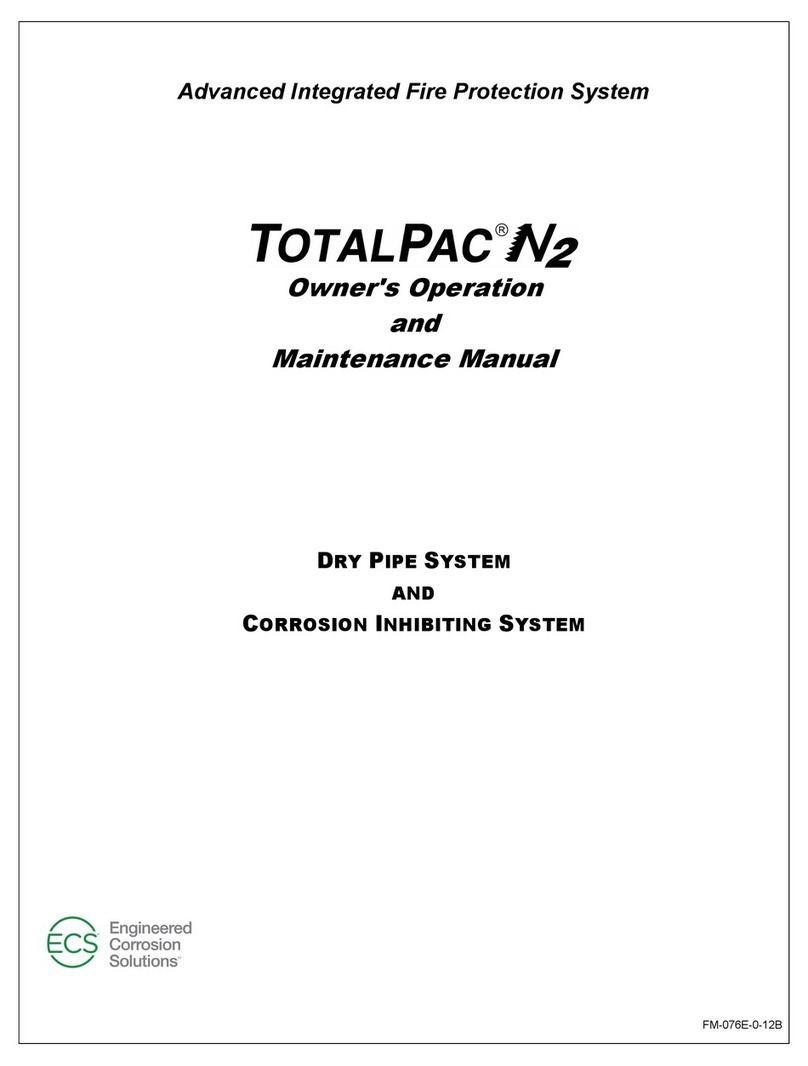
FireFlex
FireFlex TOTALPAC N2 Installation guide
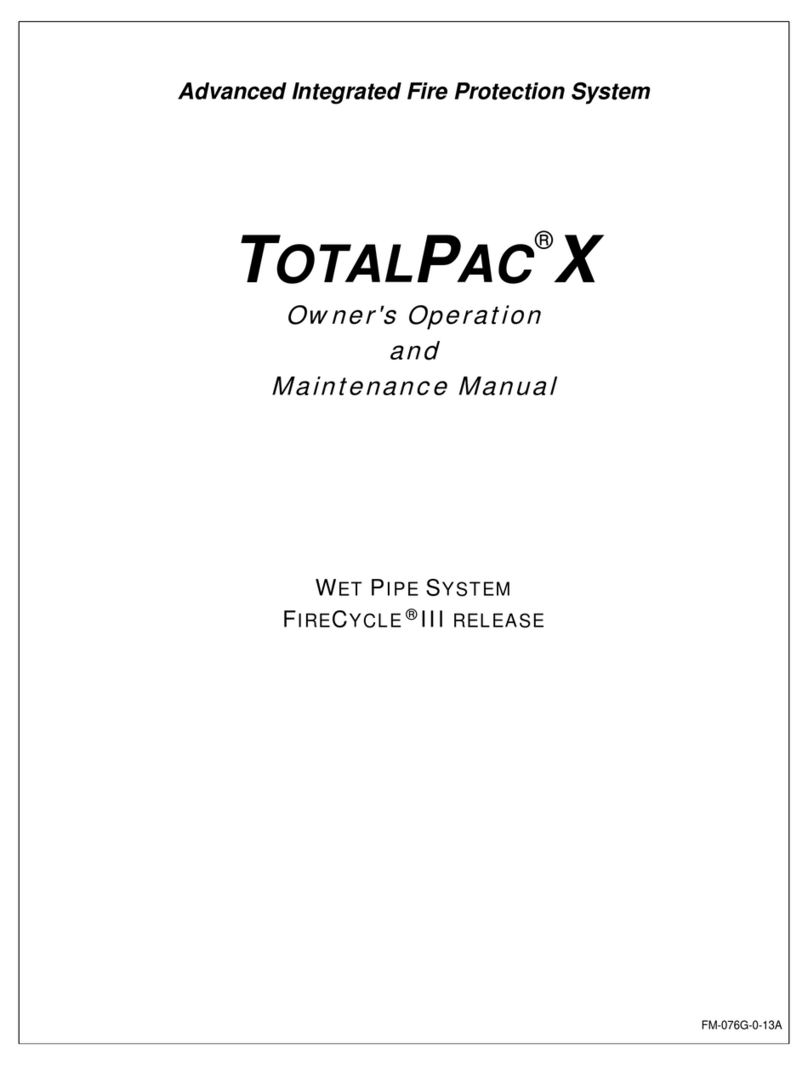
FireFlex
FireFlex TOTALPAC X Installation guide

FireFlex
FireFlex TOTALPAC X Installation guide
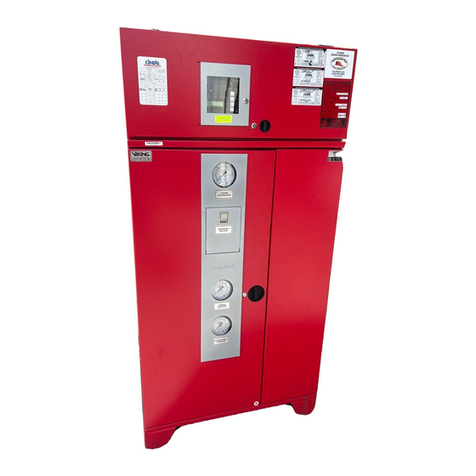
FireFlex
FireFlex TOTALPAC2 Manual

FireFlex
FireFlex TOTALPAC X Installation guide

FireFlex
FireFlex TOTALPAC2 User manual

FireFlex
FireFlex TOTALPAC N2 Installation guide

FireFlex
FireFlex TOTALPAC X Installation guide
